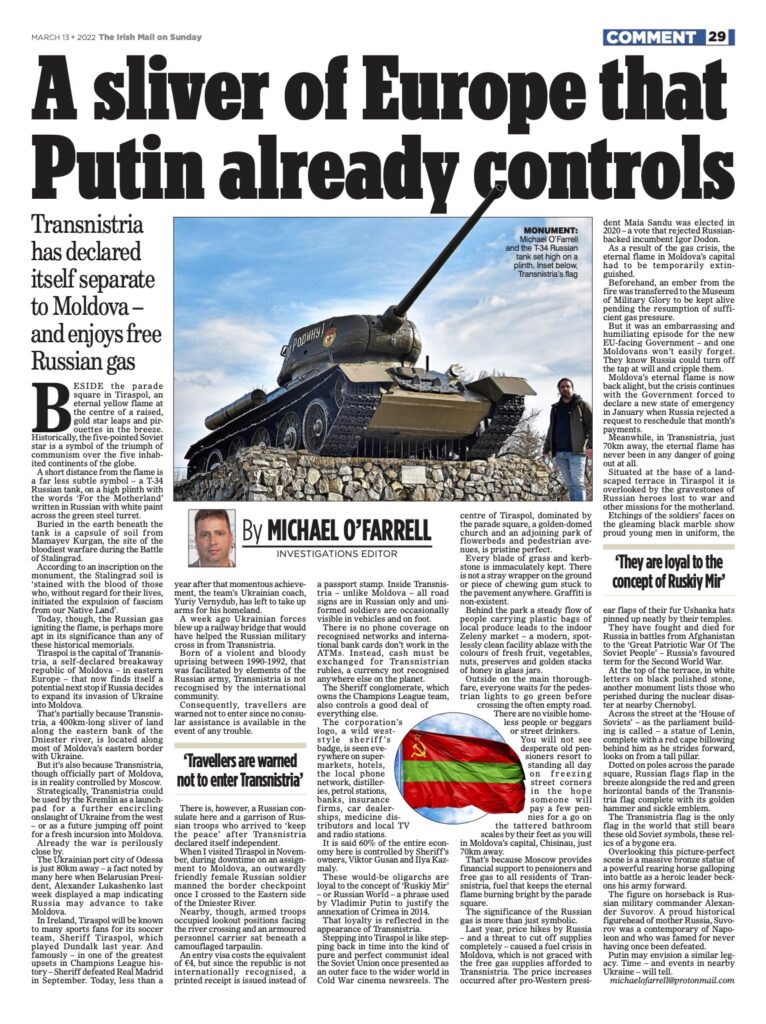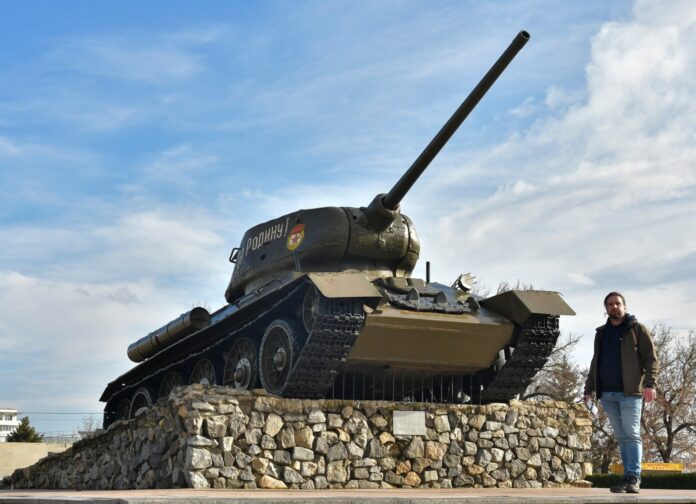BESIDE the parade square in Tiraspol, an eternal yellow flame at the centre of a raised, gold star leaps and pirouettes in the breeze.
Historically, the five-pointed Soviet star is a symbol of the triumph of communism over the five inhabited continents of the globe.
A short distance from the flame is a far less subtle symbol – a T-34 Russian tank, on a high plinth with the words ‘For the Motherland’ written in Russian with white paint across the green steel turret.
Buried in the earth beneath the tank is a capsule of soil from Mamayev Kurgan, the site of the bloodiest warfare during the Battle of Stalingrad.
According to an inscription on the monument, the Stalingrad soil is ‘stained with the blood of those who, without regard for their lives, initiated the expulsion of fascism from our Native Land’.
Today, though, the Russian gas igniting the flame, is perhaps more apt in its significance than any of these historical memorials.
Tiraspol is the capital of Transnistria, a self-declared breakaway republic of Moldova – in eastern Europe – that now finds itself a potential next stop if Russia decides to expand its invasion of Ukraine into Moldova.

That’s partially because Transnistria, a 400km-long sliver of land along the eastern bank of the Dniester river, is located along most of Moldova’s eastern border with Ukraine.
But it’s also because Transnistria, though officially part of Moldova, is in reality controlled by Moscow.
Strategically, Transnistria could be used by the Kremlin as a launchpad for a further encircling onslaught of Ukraine from the west – or as a future jumping off point for a fresh incursion into Moldova.
Already the war is perilously close by.
The Ukrainian port city of Odessa is just 80km away – a fact noted by many here when Belarusian President, Alexander Lukashenko last week displayed a map indicating Russia may advance to take Moldova.
In Ireland, Tiraspol will be known to many sports fans for its soccer team, Sheriff Tiraspol, which played Dundalk last year. And famously – in one of the greatest upsets in Champions League history – Sheriff defeated Real Madrid in September.
Today, less than a year after that momentous achievement, the team’s Ukrainian coach, Yuriy Vernydub, has left to take up arms for his homeland.
Stepping into Tiraspol is like stepping back in time into the kind of pure and perfect communist ideal the Soviet Union once presented as an outer face to the wider world in Cold War cinema newsreels.
A week ago Ukrainian forces blew up a railway bridge that would have helped the Russian military cross in from Transnistria.
Born of a violent and bloody uprising between 1990-1992, that was facilitated by elements of the Russian army, Transnistria is not recognised by the international community.
Consequently, travellers are warned not to enter since no consular assistance is available in the event of any trouble.
There is, however, a Russian consulate here and a garrison of Russian troops who arrived to ‘keep the peace’ after Transnistria declared itself independent.
When I visited Tiraspol in November, during downtime on an assignment to Moldova, an outwardly friendly female Russian soldier manned the border checkpoint once I crossed to the Eastern side of the Dniester River.
Nearby, though, armed troops occupied lookout positions facing the river crossing and an armoured personnel carrier sat beneath a camouflaged tarpaulin.
An entry visa costs the equivalent of €4, but since the republic is not internationally recognised, a printed receipt is issued instead of a passport stamp.
Inside Transnistria – unlike Moldova – all road signs are in Russian only and uniformed soldiers are occasionally visible in vehicles and on foot.
There is no phone coverage on recognised networks and international bank cards don’t work in the ATMs. Instead, cash must be exchanged for Transnistrian rubles, a currency not recognised anywhere else on the planet.
The Sheriff conglomerate, which owns the Champions League team, also controls a good deal of everything else.
The Transnistria flag is the only flag in the world that still bears these old Soviet symbols, these relics of a bygone era.
The corporation’s logo, a wild weststyle sheriff’s badge, is seen everywhere on supermarkets, hotels, the local phone network, distilleries, petrol stations, banks, insurance firms, car dealerships, medicine distributors and local TV and radio stations.
It is said 60% of the entire economy here is controlled by Sheriff’s owners, Viktor Gusan and Ilya Kazmaly. These would-be oligarchs are loyal to the concept of ‘Ruskiy Mir’ – or Russian World – a phrase used by Vladimir Putin to justify the annexation of Crimea in 2014.
That loyalty is reflected in the appearance of Transnistria.
Stepping into Tiraspol is like stepping back in time into the kind of pure and perfect communist ideal the Soviet Union once presented as an outer face to the wider world in Cold War cinema newsreels.
The centre of Tiraspol, dominated by the parade square, a golden-domed church and an adjoining park of flowerbeds and pedestrian avenues, is pristine perfect.
Every blade of grass and kerbstone is immaculately kept. There is not a stray wrapper on the ground or piece of chewing gum stuck to the pavement anywhere. Graffiti is non-existent.
Behind the park a steady flow of people carrying plastic bags of local produce leads to the indoor Zeleny market – a modern, spotlessly clean facility ablaze with the colours of fresh fruit, vegetables, nuts, preserves and golden stacks of honey in glass jars.
Outside on the main thoroughfare, everyone waits for the pedestrian lights to go green before crossing the often empty road.
There are no visible homeless people or beggars or street drinkers.
You will not see desperate old pensioners resort to standing all day on freezing street corners in the hope someone will pay a few pennies for a go on the tattered bathroom scales by their feet as you will in Moldova’s capital, Chisinau, just 70km away.
That’s because Moscow provides financial support to pensioners and free gas to all residents of Transnistria, fuel that keeps the eternal flame burning bright by the parade square.
The significance of the Russian gas is more than just symbolic.
Last year, price hikes by Russia – and a threat to cut off supplies completely – caused a fuel crisis in Moldova, which is not graced with the free gas supplies afforded to Transnistria. The price increases occurred after pro-Western president
Maia Sandu was elected in 2020 – a vote that rejected Russianbacked incumbent Igor Dodon.
As a result of the gas crisis, the eternal flame in Moldova’s capital had to be temporarily extinguished. Beforehand, an ember from the fire was transferred to the Museum of Military Glory to be kept alive pending the resumption of sufficient gas pressure.
But it was an embarrassing and humiliating episode for the new EU-facing Government – and one Moldovans won’t easily forget. They know Russia could turn off the tap at will and cripple them.
Moldova’s eternal flame is now back alight, but the crisis continues with the Government forced to declare a new state of emergency in January when Russia rejected a request to reschedule that month’s payments.
Meanwhile, in Transnistria, just 70km away, the eternal flame has never been in any danger of going out at all.
Situated at the base of a landscaped terrace in Tiraspol it is overlooked by the gravestones of Russian heroes lost to war and other missions for the motherland.
Etchings of the soldiers’ faces on the gleaming black marble show proud young men in uniform, the ear flaps of their fur Ushanka hats pinned up neatly by their temples.
They have fought and died for Russia in battles from Afghanistan to the ‘Great Patriotic War Of The Soviet People’ – Russia’s favoured term for the Second World War.
At the top of the terrace, in white letters on black polished stone, another monument lists those who perished during the nuclear disaster at nearby Chernobyl.
Across the street at the ‘House of Soviets’ – as the parliament building is called – a statue of Lenin, complete with a red cape billowing behind him as he strides forward, looks on from a tall pillar.
Dotted on poles across the parade square, Russian flags flap in the breeze alongside the red and green horizontal bands of the Transnistria flag complete with its golden hammer and sickle emblem.
The Transnistria flag is the only flag in the world that still bears these old Soviet symbols, these relics of a bygone era.
Overlooking this picture-perfect scene is a massive bronze statue of a powerful rearing horse galloping into battle as a heroic leader beckons his army forward.
The figure on horseback is Russian military commander Alexander Suvorov. A proud historical figurehead of mother Russia, Suvorov was a contemporary of Napoleon and who was famed for never having once been defeated.
Putin may envision a similar legacy. Time – and events in nearby Ukraine – will tell.

